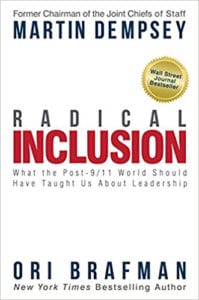 As an undergrad at Berkeley, Ori Brafman had been many things—a peace and conflict studies major, anti-war protestor, and vegan activist whose McVegan campaign had taken on McDonald’s and won. The last place he thought he’d find himself a decade later was in the office of a 4-star army general. “At the time, I had no idea what a 4-star general was,” admits Brafman, BA 97, a Berkeley Haas lecturer who teaches improvisational leadership in the MBA and undergraduate programs. “My first question was, ‘Is there a 5-star general?’”
As an undergrad at Berkeley, Ori Brafman had been many things—a peace and conflict studies major, anti-war protestor, and vegan activist whose McVegan campaign had taken on McDonald’s and won. The last place he thought he’d find himself a decade later was in the office of a 4-star army general. “At the time, I had no idea what a 4-star general was,” admits Brafman, BA 97, a Berkeley Haas lecturer who teaches improvisational leadership in the MBA and undergraduate programs. “My first question was, ‘Is there a 5-star general?’”
Yet, that meeting in 2009 with Former Chairman of the Joint Chiefs of Staff Martin Dempsy would lead to an unlikely collaboration examining just how much the definition of leadership has changed in the era between the Twin Towers attack and the rise of “fake news.” Their ongoing conversation has culminated in the publication of a new book, Radical Inclusion: What the Post-9/11 World Should Have Taught Us About Leadership.
The economic case for inclusion
The book makes the case that in military bunkers and corporate boardrooms alike, leadership today means bringing everyone into the fold.
“Typically we look at inclusion as something that’s nice to have from a psychological perspective,” Brafman says. But he and Dempsey argue that including everyone in a way that gives them stake in decision-making makes economic sense as well. Members of an organization who don’t feel a sense of buy-in will be a drag on productivity, or jump ship altogether, costing time and energy in finding their replacements. “From an economic perspective, you are actually paying a cost for control. You need to ask yourself if you could achieve the results through inclusion in a more economically efficient way,” Brafman says.
At the same time, inclusion is vital to communication, for leaders to both receive and transmit essential truths. “You need inclusion to get better information from the edges of the network and also to be able to analyze that data. And you need enough different people around you, so you are not surprised by a piece of data when it comes in,” Brafman says.
Radical inclusion lessons from Burning Man
 Dempsey contacted Brafman after the publication of his first book, the Starfish and the Spider, which argues for the effectiveness of distributed networks over top-down hierarchy. A New York Times bestseller, the book resonated with everyone from Greenpeace to the Tea Party. It also struck a chord in the military, which had been struggling to diffuse authority in order to counter the threat posed by distributed terrorist networks in the wake of 9/11.
Dempsey contacted Brafman after the publication of his first book, the Starfish and the Spider, which argues for the effectiveness of distributed networks over top-down hierarchy. A New York Times bestseller, the book resonated with everyone from Greenpeace to the Tea Party. It also struck a chord in the military, which had been struggling to diffuse authority in order to counter the threat posed by distributed terrorist networks in the wake of 9/11.
In their first meeting, Brafman showed the general slides from Burning Man, the famously hedonistic annual gathering of artists and iconoclasts in the Nevada desert. The power of the event, Brafman insisted, came from the fact that everyone is welcomed—and everyone is encouraged to participate—creating an intimate sense of shared purpose among diverse individuals which enables them to create a successful gathering in the harshest of conditions.
As Brafman began talking to Dempsey, however, he realized that he had just as much to learn from the Army’s strengths in this same area. “A big part of their sauce is that they engender a sense of belonging,” he says. That sense of belonging is the first key to inclusion, the authors write. “The most important responsibility of leaders—no matter how busy they are and how many other priorities demand their attention—is to make their people feel like they belong.” The way to do that, they continue, is to devote time into building shared memories—whether it’s a kind word in the hallway or on the battlefield, or an unexpected phone call or visit—that makes people feel like they are valued participants whose work matters to the organization.
Amplifying voices
Beyond making employees feel included, Brafman and Dempsey say, leaders must also communicate both inside and outside the organization in an inclusive way. In a world of distributed information, organizations can no longer count on persuading audiences with facts alone. As organizations compete with viral videos and “fake news,” they must also create the best story. “As a leader you are responsible for creating a narrative of the organization both internally and externally,” says Brafman. “Then your job becomes how do I create a sense of ownership and involvement with that narrative.”
Brafman and Dempsey further distill their own message into six leadership lessons, such as “Co-Create Context” and “Relinquish Control,” which help to apply the principles of inclusion to create a successful organization. “If you are saying I need to control my people, then you might have control, but you are not going to win in this market,” Brafman says. “Right now, listening and amplifying voices and winning the competition of narratives is much more important.”